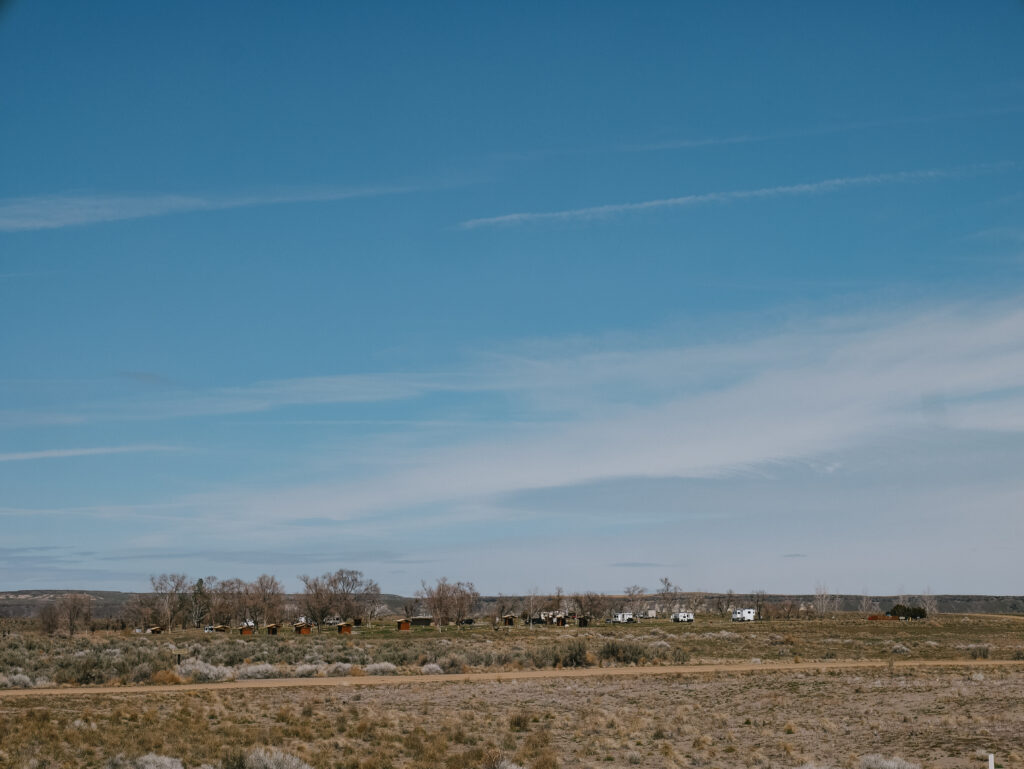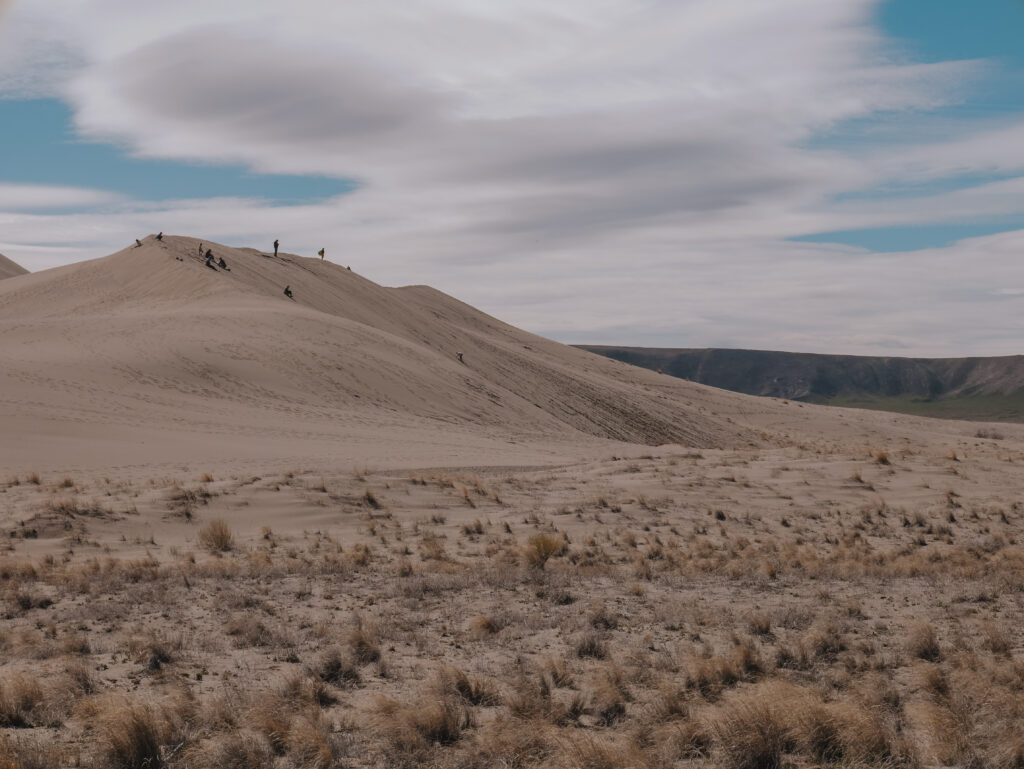When people think of Idaho, sand dunes aren’t usually the first thing that come to mind. But southern Idaho actually has multiple dune areas. Bruneau Dunes State Park is a great place to do some hiking, bird watching, sandboarding, and camping around the largest sand dune in North America. Furthermore, the park is only a short jaunt from Boise, making it a convenient spot to visit from the city.

Getting to Bruneau Dunes State Park
Bruneau Dunes State Park sits southeast of Boise, about an hour away from the city’s downtown. Head down I-84 E and exit in the town of Mountain Home. Then, head south on ID-51 until you turn left on Marsing Murphy Road (78) near the Snake River and CJ Strike Wildlife Management Area.
After a short ways, turn right on Bruneau Sand Dunes Road and follow it until you reach the visitor’s center and parking area. For a park map, click here.
Fees & Regulations
Entry to Bruneau Dunes State Park costs $7 per vehicle for Idaho residents and $14 for non-residents. We’d recommend bringing exact change in cash to pay any fees, as the entrance booth is often unmanned and you may have to use the self-pay envelope station.
For Idaho residents, campsites cost $17+ per night. For non-residents sites cost $22+ per night. There are also cabins at the state park, which cost $80-$90 per night.
Pets are permitted at Bruneau Dunes State Park on leash, but can be off leash in the designated pet area near the campgrounds. You may fly a drone only in the designated area near the visitor’s center. The park does not permit the use of gas-powered boats on the lakes.

Hours
The park is open year round. Day use areas (including the dunes) are open from 7 a.m. until 10 p.m.
The observatory is open mid-March through mid-October on Fridays, Saturdays, and some holidays. Check the park page for more information and updates.
If you plan to camp, check-in starts at 2 p.m. and check out is at 1 p.m.
Activities at Bruneau Dunes State Park
Trails
Equestrian Trails: If you want to explore Bruneau Dunes on horseback there are two loops – a seven and a nine-mile trail. These head from the visitor’s center and skirt along the boundaries of the park and near the campgrounds.
Hiking Trails: There are also a couple hiking loop options. We did the 6-mile loop, which was a great way to see most of the park. We headed from the visitor’s center early in the morning to avoid the heat of the day. The trail led through the grassland area at the base of the dunes where we saw plenty of birds and rabbits.
We then made the steep trek up the side of Big Dune. This the largest dune in North America, standing at about 470 feet tall. The view from the top was quite pretty as we walked along the crest, taking in the surrounding wetlands, dunes, and mountains in the distance.

After taking in the views, we made our way down the dune around the lakes until we reached the campgrounds. Even though it was only March, it was already quite hot at that point in the day. To end our hike, we looped back to the visitor’s center.
There are trail markers along the trails, but they aren’t always obvious. But, it’s hard to get lost since you can see the visitor’s center and other main landmarks most of the way. Here’s a park map if you’d like to take a look at the other routes, distances, and park layout.

Camping
There are three campgrounds at Bruneau Dunes State Park. Eagle Cove Campground and Broken Wheel Campground both sit east of the visitor’s center and the Equestrian Campground sits just by it. There are over 100 sites, some of which are basic tent sites and some have electric hookups. You can reserve sites online beforehand or by calling the number listed on the Idaho Parks webpage. If sites are available, you may also walk up and pay for a site without a prior reservation. Fees are listed in the above fees section.
If you’d like something a little scaled up from a camp spot, there are a couple basic cabins available as well. They are a great option to consider in the summer if you’d like some AC. These can also be reserved online. Note that there are some extra regulations for the cabins that include no cooking inside, no pets in one of the cabins, visitor’s must bring their own bedding, etc.

Sand Boarding
Sand boarding or sledding is a popular activity here, and it’s quite fun to speed down the dunes.
The visitor’s center offers both stand-up boards and sleds for $15 per day for a board or $25 for two boards. If the temperature exceeds 80°F, the park stops rentals. You may also bring your own if you have them!

Observatory
This area of Idaho is known for its incredible starry skies. There is an observatory at Bruneau Dunes State Park where visitors can learn more about space through video showings, presentations by astronomers, and by taking a peek through one of the telescopes.
There is an extra fee of $5 per person to use the telescopes, tour the observatories, etc. As mentioned in the hours section above, viewings are only available seasonally a couple nights per week. They are also subject to weather. We’d recommend reaching out to the park beforehand or checking the Facebook page for updates or to answer any questions.

Enjoying the Lakes
There are a couple small lakes in Bruneau Dunes State Park. Visitors can fish, swim, kayak and boat. There are also many birds thriving here, making this a popular spot for bird watching.
If you plan to fish, bring your fishing license. Note that gas-powered boats are not allowed.

What to Bring to Bruneau Dunes State Park
Water: Bring plenty of water to stay hydrated. You can also purchase water at the visitor’s center.
Cash: To pay the entrance fee and fees associated with any other activities in the park.
Reservation: Don’t forget your reservation information if you purchase a campground reservation in advance.
Comfortable Shoes: Whether you plan on hiking the trails, sandboarding, or are just walking around the camp areas, bring comfortable shoes to protect your feet from the prickly vegetation and sand when it reaches extreme temperatures.
Sandboard/Sled: If you want to bring your own. Note that not all materials slide well on the sand as they do on snow.
Bug Spray: It can get pretty buggy around the lakes, especially near dawn and dusk.
Sunglasses: To protect your eyes from both the sun and blowing sand.
Other Sun Protection: There’s very little shade out here, so bring sunglasses and/or a hat.
Misc. Gear: Any extra gear you need, such as camping gear, fishing poles, kayaks, etc.
Like this Post? Pin it!




